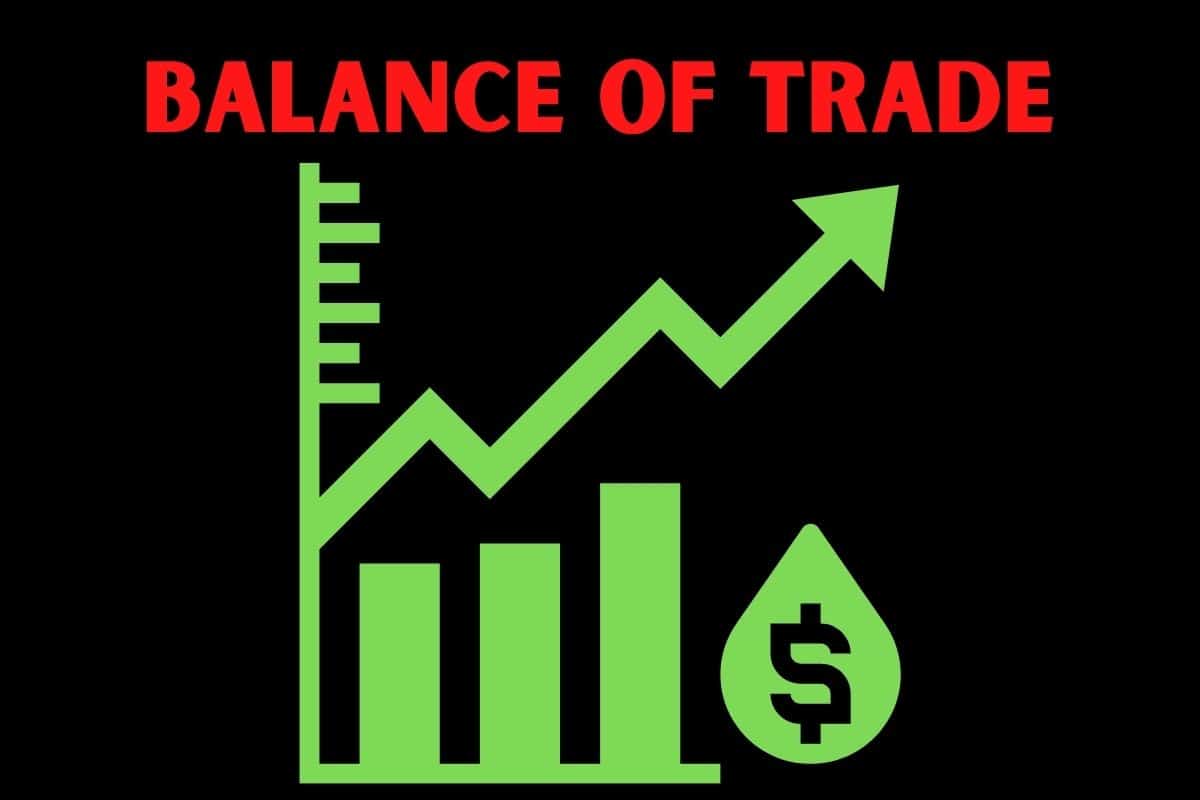Balance of Trade( BOT) is a key indicator of economic growth and a large part of a country’s GDP. In other words, BOT has a significant effect on the economy of a given country. Figures from the BOT must be understood in the context of the current economy, economic policies, and the country’s economic cycles. Read further to fully understand Balance of trade, its components, formula, and calculations. Also, you will get a hint on how BOT affects a nation’s economy.
Read my post on Favourable Balance of Trade for more knowledge.
Understanding Balance of Trade
The Balance of Trade (BoT) is the difference between the total value of exports and the total value of imports in a given period. It is also known as trade balance, commercial balance, or net exports (NX).
Balance of Trade is to be paid as a measure of the value of locally produced goods and services through outsourcing (exportation) and the imported products (imports) over the period. Consequently, the BOT is considered the main economic indicator of international commercial payment activities and an important parameter for evaluating economic consumption.
While the total value of exports is superior to all imports, the Balance of Trade is positive and has commercial excellence. This excellent commercial sign makes a profit in international commerce. The government can use the additional budget to increase local investments to improve the living level or foreign investments to create new sources of return for the country.
While the total value of exports is lower than that of imports, the Balance of Trade is harmful and has a commercial deficit. A commercial deficit that pays less than it should does not increase on the world stage. As a result, the government must pour a counter-meter in place of new taxes, print other payments, or rely on international financial institutions such as the International Monetary Fund (IMF) to cover the budget deficit.
Balance of Payment (BOP)
BoT is the largest part of the balance of payments (BoP), which is the balance of the international financial activities of a country. It consists of a current account (international commercial transactions), BoT, and a capital account (international investment transactions).
BoP is the sum of all incoming and outgoing transactions between the economic entities on the payroll and the rest of the world. In theory, the two components constantly balance and produce a balance of zero-sum payments. However, the different economic policies and fluctuations of the change rates are driven by the discharges.
What are the Types of Balance of Trade?
The types of balance of trade are:
- Trade balance
- Primary balance
- Secondary balance
The trade balance, which records the difference between the value of our exports and imports of goods and services, is usually given the most attention in economic analysis or commentary.
Components of Balance of Trade
Economic products including in the calculation of Balance of Trade are classified in goods or services and their prices have a direct influence on the values of export and import.
Goods are tangible materials produced locally, providing nutrition and energy supplies.
Services are based on human interactions, taking a bite or removing responsibility for a piece. The port of the services can be used for diversion and training at the same time and place.
Prices of goods and services depend initially on production costs, such as primary materials, storage, transport, and personal dispensers. For example, ground fluctuations occur at the manufacturers of petrol products to adjust their prices to reflect changes.
The productive profit margin of the manufacturer is augmented as a function of the local off/demand ratio. The amounts of supply and demand vary from company to company and are heavily affected by the economic and fiscal conditions that lead to inflation and taxes.
External demand is the final determinant of prices. As long as the foreign currency is higher than the local currency, Viagra generic companies naturally prefer to export their products and realize the most elevated benefits. Consequently, the export routes are continuously increasing, which is retrospectively feasible for foreign accelerators.
On the other hand, high demand in a certain industry makes companies more likely to import goods, preferably at low prices, so the total value of imports goes up. In other words, the nominal prices on the internal margins go up, which makes the exports less valuable.
How to Calculate Balance of Trade?
To compare imports and exports, the Balance of Trade with evidence of the effectiveness of a country’s international commercial activities. The BoT formula is as follows:
TB (Balance of Trade) = X (total value of exports) – M (total value of imports)
The calculation can differ depending on the pay. For example, the main ratio of the eurozone’s trade balance with France does not match prices or account for services. The French Balance of Trade in services is calculated separately, and the two categories are regrouped in a different report.
How the Balance of Trade Affects the Economy?
The Balance of Trade reveals that it generates additional resources beyond its local capacity at the end of the value chain. As a key indicator of economic growth and a large part of the gross domestic product (GDP), BOT figures are closely watched by governments and central banks to improve their policies. Commercial excellence is generally the PIB, although there is a commercial capacity deficit.
Underneath the breakdown of wages is an indicator of a positive commercial balance, an excess or a deficit in the index, without necessarily indicating a force or an economic failure. Figures from the BOT must be understood in the context of the current economy, economic policies, and the country’s economic cycles.
#1. Export- and Demand-led Growth Strategies
During an economic recession, the government can adopt and stimulate the Greek economy with a crop-driven export strategy. The goal is to think of outsourced resources as being paid for by increasing the number of outlets for outsiders. Consequently, an excellent commercial deficit results from commercial and political deficits.
However, if the economy expands, an economic contraction policy will keep inflation rates in check with demand-driven demand. Importing more foreign goods and services could favor competition by lowering prices in the national economy. So, a commercial deficit leads to a natural consensus, which is a unique commercial sign of inefficient import activities.
#2. Trade wars
If health and how well the economy works are important, their economic policies will affect other things. Commercial warfare between the largest consumer and the largest producer in the world, the United States and China, is a good example.
In 2018, the United States ran a short-term trade deficit with China totaling $ 375 billion. As a result, President Donald Trump has accused China of violating international commercial practices with the United States by manipulating foreign exchange, the volume of intellectual property owned, and with an accent resting on the march.
In response to the accusations, China says that Trump is using his economic power to force them to do what he wants. So, commercial warfare didn’t start until the U.S. put a 25% tariff on some Chinese products and quickly raised it to the point where Chinese imports were being treated differently.
Since the United States uses a strategy driven by what people want, widespread imports go against economic policy. The US commercial deficit stays the same and falls within the value of the US dollar compared to other currencies. This is because import numbers are going down.
How Do You Measure Trade Balance?
The trade balance is the value of a country’s exports less than its imports. Exports are goods or services produced in the United States and sold to foreigners.
What Factors Influence the Trade Balance?
Fiscal policy, demographics, and weak domestic demand are among these factors. Exchange rate policies and domestic supply-side policies, such as subsidies to state-owned enterprises or export sectors, may also be included. On the other hand, tariff changes had a much smaller impact on trade balances.
Is High Trade Balance Good?
A trade surplus can boost the economy’s employment and economic growth and raise prices and interest rates. The value of a nation’s currency on international exchange markets can also be impacted by its trade balance because it enables that nation to trade away the majority of its money.
Balance of Trade as an Economic Indicator
The Balance of Trade is a retarded economic indicator and is not retrospective. A positive BoT digit indicates that the total value of exports increased versus imports during the reference period, even as a negative commercial balance ratio suggests the opposite. Several factors influence the commercial balance:
- Principal national industries and their internal conditions, such as local supply/demand
- Coats of primary materials and intermediate goods
- Fluctuations in change rates
- Commercial policies, taxes, regulations, and restrictions
- International relations with the main commercial partners
- Personalized controls
In financial transactions, the BoT is used as an economic indicator of the economic viability of payroll and its proximity to economic policy objectives. Commodities that follow BoT publications to evaluate international trade performance and reduce crop potential to be realized and expanded are a good predictors of future PIB and government fiscal policy.
How to use the Balance of Trade Reports?
Balance of Trade is an important part of reality. The ratio’s effect on a currency’s value differs depending on economic policies and sentiment. In an economy that depends on exports, a rise in commercial output is good for the economy. In contrast, in an economy driven by demand, there is a growing increase in the commercial deficit.
Why is BOT Important?
The balance of trade is an important factor in calculating a country’s Gross Domestic Product. Exports are added to GDP calculations, and imports are subtracted from the total. As a result, the greater a country’s trade surplus, the greater its GDP.
Should Trade Balance be Positive or Negative?
Economists generally agree that trade surpluses and deficits are not fundamentally “bad” or “good” for the economy. A positive balance arises when exports exceed imports and is known as a trade surplus.
Balance of Trade FAQs
What is an example of balance of trade?
Balance of Trade formula = country’s exports minus country’s imports. For example, if the US bought $1.8 trillion worth of goods from other countries in 2016 but only sold $1.2 trillion worth of goods to other countries, it would have a -$600 billion trade balance, or a $600 billion trade deficit.
What are the components of balance of trade?
The difference between how much a country buys and sells is called its balance of trade. The current, financial, and capital accounts are the three parts of the balance of payments.
What is the importance of balance of trade?
Balance of trade is an important part of a country’s balance of payments and an important indicator of the country’s trade. A country’s trade surplus is shown by a positive balance of trade, while a negative balance of trade shows a trade deficit.
{
“@context”: “https://schema.org”,
“@type”: “FAQPage”,
“mainEntity”: [
{
“@type”: “Question”,
“name”: “What is an example of balance of trade?”,
“acceptedAnswer”: {
“@type”: “Answer”,
“text”: “
Balance of Trade formula = country’s exports minus country’s imports. For example, if the US bought $1.8 trillion worth of goods from other countries in 2016 but only sold $1.2 trillion worth of goods to other countries, it would have a -$600 billion trade balance, or a $600 billion trade deficit.
“
}
}
, {
“@type”: “Question”,
“name”: “What are the components of balance of trade?”,
“acceptedAnswer”: {
“@type”: “Answer”,
“text”: “
The difference between how much a country buys and sells is called its balance of trade. The current, financial, and capital accounts are the three parts of the balance of payments.
“
}
}
, {
“@type”: “Question”,
“name”: “What is the importance of balance of trade?”,
“acceptedAnswer”: {
“@type”: “Answer”,
“text”: “
Balance of trade is an important part of a country’s balance of payments and an important indicator of the country’s trade. A country’s trade surplus is shown by a positive balance of trade, while a negative balance of trade shows a trade deficit.
“
}
}
]
}






